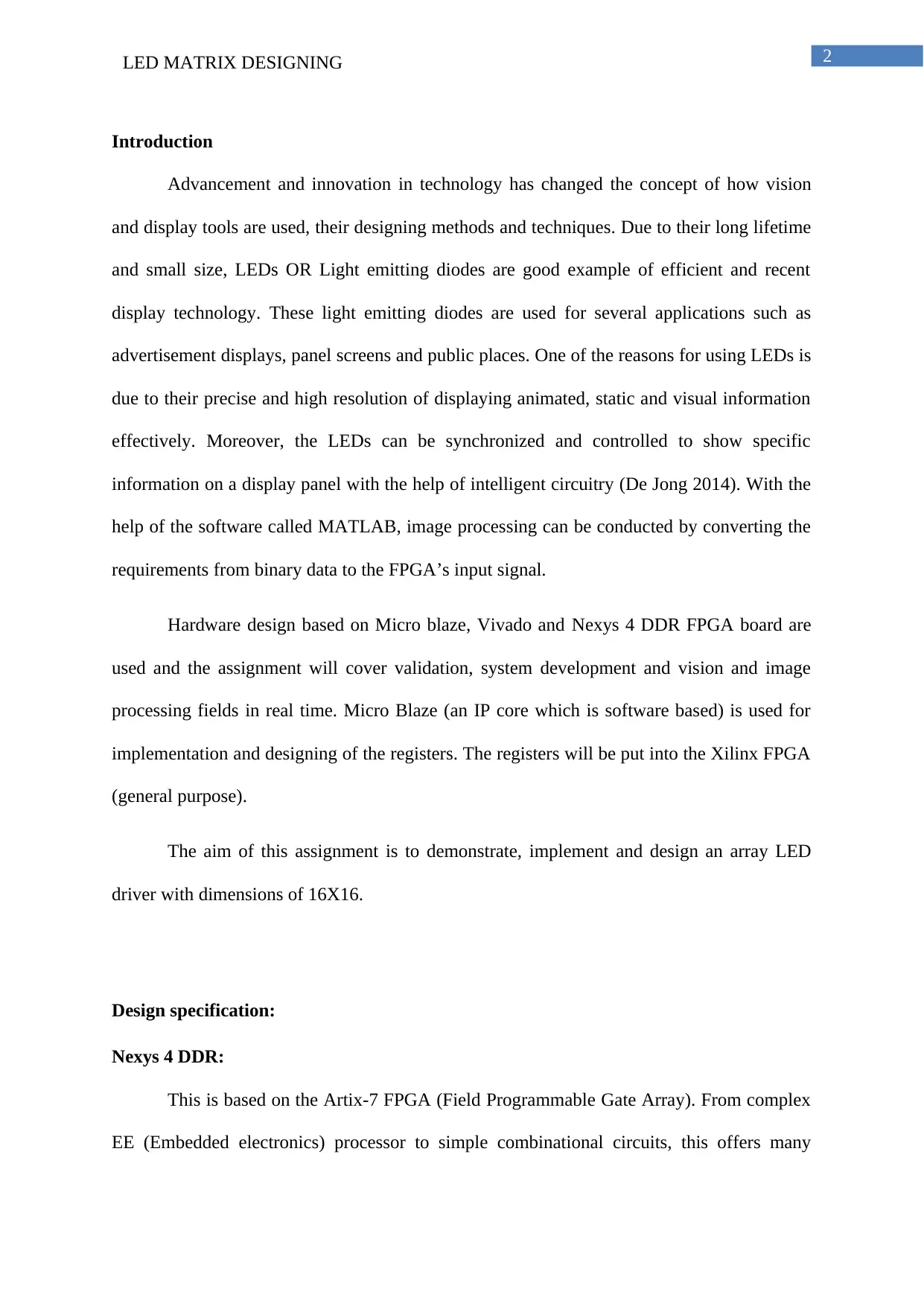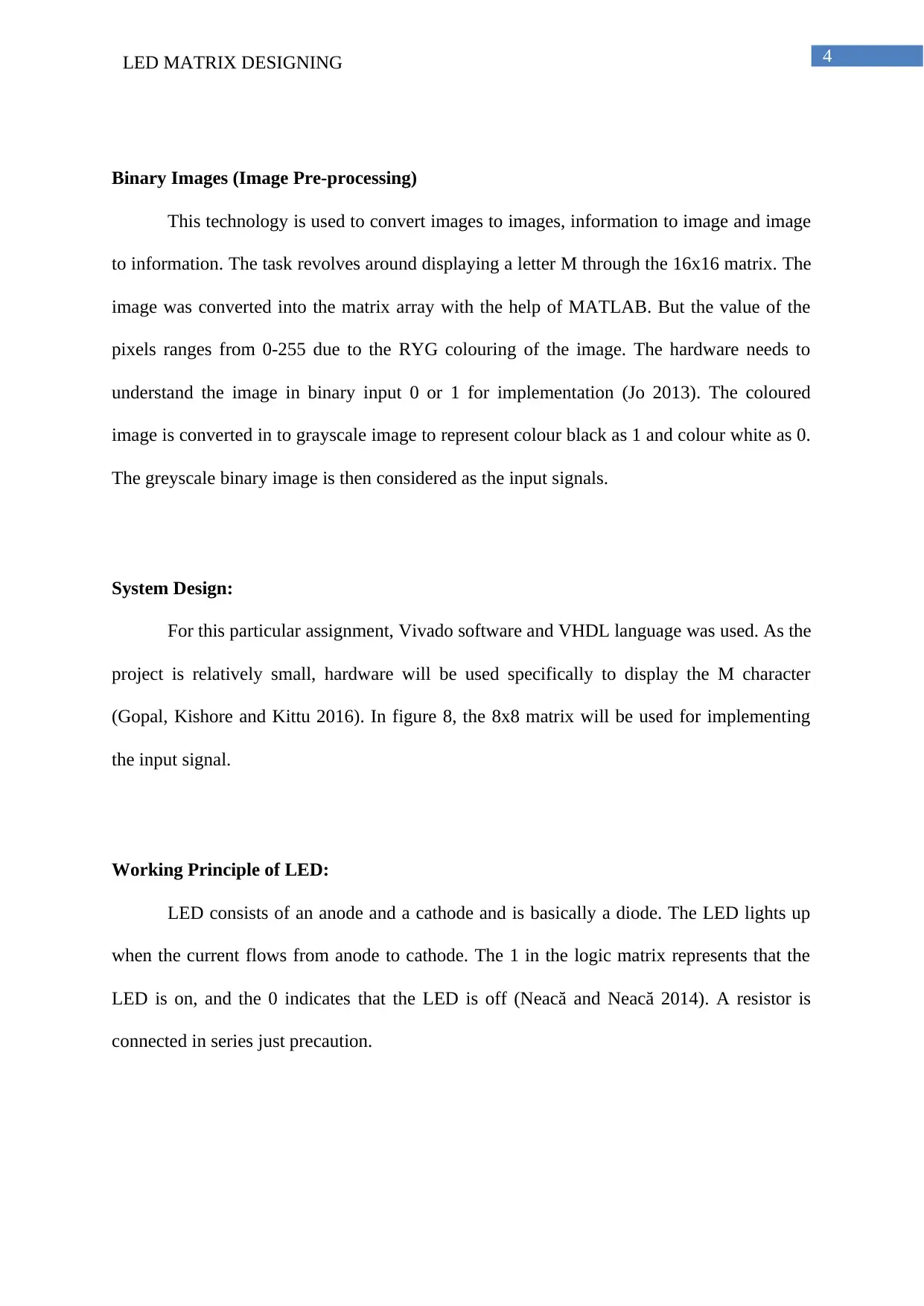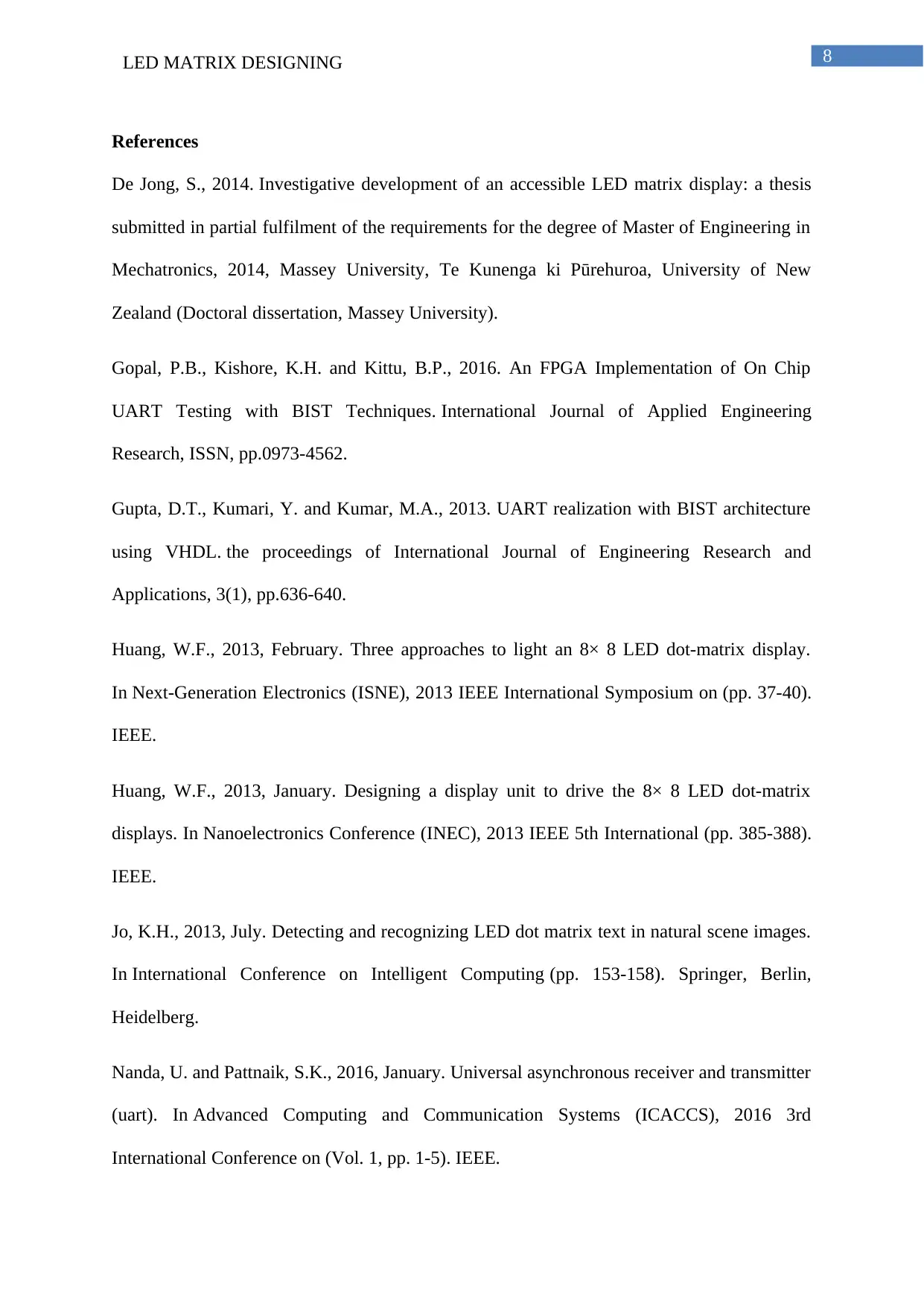LED Matrix Designing: A Study on Hardware and Software Implementation
VerifiedAdded on 2023/06/13
|10
|2080
|442
AI Summary
This study focuses on the implementation of LED matrix designing using hardware and software. It covers the design specification, system design, and working principle of LED. The study also discusses the use of Nexys 4 DDR and MATLAB software for image processing.
Contribute Materials
Your contribution can guide someone’s learning journey. Share your
documents today.

Running head: LED MATRIX DESIGNING
LED MATRIX DESIGNING
Name of the University
Name of the student
Author Note
LED MATRIX DESIGNING
Name of the University
Name of the student
Author Note
Secure Best Marks with AI Grader
Need help grading? Try our AI Grader for instant feedback on your assignments.

1LED MATRIX DESIGNING
Table of Contents
Introduction................................................................................................................................3
Design specification:..................................................................................................................3
Nexys 4 DDR:........................................................................................................................3
LED or Light Emitting Diodes:..............................................................................................4
Nexys 4 DDR Design Package:.................................................................................................4
Software.................................................................................................................................4
Binary Images (Image Pre-processing)..................................................................................4
System Design:.......................................................................................................................5
Working Principle of LED:....................................................................................................5
The design idea:.....................................................................................................................5
Discussion..................................................................................................................................6
Conclusion..................................................................................................................................7
References..................................................................................................................................7
Table of Contents
Introduction................................................................................................................................3
Design specification:..................................................................................................................3
Nexys 4 DDR:........................................................................................................................3
LED or Light Emitting Diodes:..............................................................................................4
Nexys 4 DDR Design Package:.................................................................................................4
Software.................................................................................................................................4
Binary Images (Image Pre-processing)..................................................................................4
System Design:.......................................................................................................................5
Working Principle of LED:....................................................................................................5
The design idea:.....................................................................................................................5
Discussion..................................................................................................................................6
Conclusion..................................................................................................................................7
References..................................................................................................................................7

2LED MATRIX DESIGNING
Introduction
Advancement and innovation in technology has changed the concept of how vision
and display tools are used, their designing methods and techniques. Due to their long lifetime
and small size, LEDs OR Light emitting diodes are good example of efficient and recent
display technology. These light emitting diodes are used for several applications such as
advertisement displays, panel screens and public places. One of the reasons for using LEDs is
due to their precise and high resolution of displaying animated, static and visual information
effectively. Moreover, the LEDs can be synchronized and controlled to show specific
information on a display panel with the help of intelligent circuitry (De Jong 2014). With the
help of the software called MATLAB, image processing can be conducted by converting the
requirements from binary data to the FPGA’s input signal.
Hardware design based on Micro blaze, Vivado and Nexys 4 DDR FPGA board are
used and the assignment will cover validation, system development and vision and image
processing fields in real time. Micro Blaze (an IP core which is software based) is used for
implementation and designing of the registers. The registers will be put into the Xilinx FPGA
(general purpose).
The aim of this assignment is to demonstrate, implement and design an array LED
driver with dimensions of 16X16.
Design specification:
Nexys 4 DDR:
This is based on the Artix-7 FPGA (Field Programmable Gate Array). From complex
EE (Embedded electronics) processor to simple combinational circuits, this offers many
Introduction
Advancement and innovation in technology has changed the concept of how vision
and display tools are used, their designing methods and techniques. Due to their long lifetime
and small size, LEDs OR Light emitting diodes are good example of efficient and recent
display technology. These light emitting diodes are used for several applications such as
advertisement displays, panel screens and public places. One of the reasons for using LEDs is
due to their precise and high resolution of displaying animated, static and visual information
effectively. Moreover, the LEDs can be synchronized and controlled to show specific
information on a display panel with the help of intelligent circuitry (De Jong 2014). With the
help of the software called MATLAB, image processing can be conducted by converting the
requirements from binary data to the FPGA’s input signal.
Hardware design based on Micro blaze, Vivado and Nexys 4 DDR FPGA board are
used and the assignment will cover validation, system development and vision and image
processing fields in real time. Micro Blaze (an IP core which is software based) is used for
implementation and designing of the registers. The registers will be put into the Xilinx FPGA
(general purpose).
The aim of this assignment is to demonstrate, implement and design an array LED
driver with dimensions of 16X16.
Design specification:
Nexys 4 DDR:
This is based on the Artix-7 FPGA (Field Programmable Gate Array). From complex
EE (Embedded electronics) processor to simple combinational circuits, this offers many

3LED MATRIX DESIGNING
designs and even includes and inbuilt development platform for digital circuits Pandey, B.,
Das, (B., Kaur et al. 2017).
LED or Light Emitting Diodes:
The array of LEDs will require a lot of interconnected connections. The 16x16 matrix
will require the cathodes of the LEDs to be connected together and the anodes of the LEDs to
be connected in a column (Yoon et al. 2014).
Nexys 4 DDR Design Package:
Software
UART: It is used to receive and send the data from the machine and host. The data
receiver works in serial to parallel while the data transmitter works in parallel to serial
(Nanda and Pattnaik 2016). The data is converted to bit stream (serial) which is fit for
processing in 11 bit packets. The 11 bit packet consist of 2 Stop bits (for Logic 1), 1start bit
(for Logic 0) and 8 data bits (Gupta, Kumari and Kumar 2013).
DDR2 SDRAM: For the falling and rising edges of the processor, double data
memory is used for processing the data clock cycles at double speed (Huang 2013).
MIG or Memory interface generator: The Xilinx Tool is the MIG which is used to
create memory interfaces in FPGAs. For running VHDL design configurations, display
maps, simulations and synthesis, the script files, UCF and RTL files are generated by the
MIG (Yedilkhan et al. 2013).
Microblaze: Microblaze is implemented with microprocessors having soft IP cores
and consists of RISC or a reduced instruction set computer. Microblaze is generally used
through echo server and Ethernet in Xilinx FPGA.
designs and even includes and inbuilt development platform for digital circuits Pandey, B.,
Das, (B., Kaur et al. 2017).
LED or Light Emitting Diodes:
The array of LEDs will require a lot of interconnected connections. The 16x16 matrix
will require the cathodes of the LEDs to be connected together and the anodes of the LEDs to
be connected in a column (Yoon et al. 2014).
Nexys 4 DDR Design Package:
Software
UART: It is used to receive and send the data from the machine and host. The data
receiver works in serial to parallel while the data transmitter works in parallel to serial
(Nanda and Pattnaik 2016). The data is converted to bit stream (serial) which is fit for
processing in 11 bit packets. The 11 bit packet consist of 2 Stop bits (for Logic 1), 1start bit
(for Logic 0) and 8 data bits (Gupta, Kumari and Kumar 2013).
DDR2 SDRAM: For the falling and rising edges of the processor, double data
memory is used for processing the data clock cycles at double speed (Huang 2013).
MIG or Memory interface generator: The Xilinx Tool is the MIG which is used to
create memory interfaces in FPGAs. For running VHDL design configurations, display
maps, simulations and synthesis, the script files, UCF and RTL files are generated by the
MIG (Yedilkhan et al. 2013).
Microblaze: Microblaze is implemented with microprocessors having soft IP cores
and consists of RISC or a reduced instruction set computer. Microblaze is generally used
through echo server and Ethernet in Xilinx FPGA.
Secure Best Marks with AI Grader
Need help grading? Try our AI Grader for instant feedback on your assignments.

4LED MATRIX DESIGNING
Binary Images (Image Pre-processing)
This technology is used to convert images to images, information to image and image
to information. The task revolves around displaying a letter M through the 16x16 matrix. The
image was converted into the matrix array with the help of MATLAB. But the value of the
pixels ranges from 0-255 due to the RYG colouring of the image. The hardware needs to
understand the image in binary input 0 or 1 for implementation (Jo 2013). The coloured
image is converted in to grayscale image to represent colour black as 1 and colour white as 0.
The greyscale binary image is then considered as the input signals.
System Design:
For this particular assignment, Vivado software and VHDL language was used. As the
project is relatively small, hardware will be used specifically to display the M character
(Gopal, Kishore and Kittu 2016). In figure 8, the 8x8 matrix will be used for implementing
the input signal.
Working Principle of LED:
LED consists of an anode and a cathode and is basically a diode. The LED lights up
when the current flows from anode to cathode. The 1 in the logic matrix represents that the
LED is on, and the 0 indicates that the LED is off (Neacă and Neacă 2014). A resistor is
connected in series just precaution.
Binary Images (Image Pre-processing)
This technology is used to convert images to images, information to image and image
to information. The task revolves around displaying a letter M through the 16x16 matrix. The
image was converted into the matrix array with the help of MATLAB. But the value of the
pixels ranges from 0-255 due to the RYG colouring of the image. The hardware needs to
understand the image in binary input 0 or 1 for implementation (Jo 2013). The coloured
image is converted in to grayscale image to represent colour black as 1 and colour white as 0.
The greyscale binary image is then considered as the input signals.
System Design:
For this particular assignment, Vivado software and VHDL language was used. As the
project is relatively small, hardware will be used specifically to display the M character
(Gopal, Kishore and Kittu 2016). In figure 8, the 8x8 matrix will be used for implementing
the input signal.
Working Principle of LED:
LED consists of an anode and a cathode and is basically a diode. The LED lights up
when the current flows from anode to cathode. The 1 in the logic matrix represents that the
LED is on, and the 0 indicates that the LED is off (Neacă and Neacă 2014). A resistor is
connected in series just precaution.

5LED MATRIX DESIGNING
The design idea:
The current flow control mechanism is the main idea for the design. The rows which
will be charged will be identified and lighted up. The rows will be calculated from the right
and counter clock will be used to control the process. The current will flow through all the
columns at the same time except the column with the LED on (Huang 2013). In simple terms,
the columns will represent current flowing from cathode to anode and the rows will represent
current flowing from anode to cathode.
As the negative and positive terminals are shared, operating the LED individually is
not possible. But cycling the rows by accurately activating the proper columns will display
the M image. The flicker will be invisible as the process is very fast (the persistence of
human vision is only 0.1 seconds) and the matrix switches on the LED at the same time
(Pervez et al. 2013). The rate of scanning the rows should be above 40Hz.
Discussion
Step 1
To provide ample time for energizing the circuit, the counter needs to be set at start
process 1000.
Step 2
The first process needs to be designed for the current to flow by writing (10000000).
Step 3
The first row of the matrix needs to be turned off as per the matrix as soon as step 2 is
conducted. To cancel the current coming from the columns, the current needs to flow through
all the columns by writing (11111111).
Step 4
The design idea:
The current flow control mechanism is the main idea for the design. The rows which
will be charged will be identified and lighted up. The rows will be calculated from the right
and counter clock will be used to control the process. The current will flow through all the
columns at the same time except the column with the LED on (Huang 2013). In simple terms,
the columns will represent current flowing from cathode to anode and the rows will represent
current flowing from anode to cathode.
As the negative and positive terminals are shared, operating the LED individually is
not possible. But cycling the rows by accurately activating the proper columns will display
the M image. The flicker will be invisible as the process is very fast (the persistence of
human vision is only 0.1 seconds) and the matrix switches on the LED at the same time
(Pervez et al. 2013). The rate of scanning the rows should be above 40Hz.
Discussion
Step 1
To provide ample time for energizing the circuit, the counter needs to be set at start
process 1000.
Step 2
The first process needs to be designed for the current to flow by writing (10000000).
Step 3
The first row of the matrix needs to be turned off as per the matrix as soon as step 2 is
conducted. To cancel the current coming from the columns, the current needs to flow through
all the columns by writing (11111111).
Step 4

6LED MATRIX DESIGNING
The next process will start at 10nsec. L The current should flow through the second
row by writing (01000000) and the current should also flow through the all columns except
Column 2 and 7 by writing (10111101). This is done to keep only the LED 7 and 2 switched
on.
Step 5
As the second and third row are almost similar the same process will be repeated. To
send the current through the third row, (00100000) needs to be written.
Step 6
The same process will be repeated for eighth, seventh, sixth, fifth and fourth rows.
Step 7
In the last process, the output M will be displayed.
The counter and the processes will finally stop.
Conclusion
Instead of the 16X16 matrix display, this assignment has focused on displaying the
letter on 8x8 matrix. The display driver was designed to execute and design the prototype for
processing the binary M image. The assignment has been successful in implementing the
experiment and displaying the output waveform. For adding Micro blaze IP block, an
integrator tool known as Vivado IP has been used. For integrating the other components into
the system, has been be used. To add MIG or Memory Interface Generator, in the Nexys 4
DDR, SDRAM memory (DDR2) has been used. For facilitating communication between the
processors, an UART or universal asynchronous receiver/transmitter has been implemented.
Due to the lack of C language support, the IP design could not be effectively
implemented in the desired design. Further enhancements could be proposed to the design
using VHDL for better implementation.
The next process will start at 10nsec. L The current should flow through the second
row by writing (01000000) and the current should also flow through the all columns except
Column 2 and 7 by writing (10111101). This is done to keep only the LED 7 and 2 switched
on.
Step 5
As the second and third row are almost similar the same process will be repeated. To
send the current through the third row, (00100000) needs to be written.
Step 6
The same process will be repeated for eighth, seventh, sixth, fifth and fourth rows.
Step 7
In the last process, the output M will be displayed.
The counter and the processes will finally stop.
Conclusion
Instead of the 16X16 matrix display, this assignment has focused on displaying the
letter on 8x8 matrix. The display driver was designed to execute and design the prototype for
processing the binary M image. The assignment has been successful in implementing the
experiment and displaying the output waveform. For adding Micro blaze IP block, an
integrator tool known as Vivado IP has been used. For integrating the other components into
the system, has been be used. To add MIG or Memory Interface Generator, in the Nexys 4
DDR, SDRAM memory (DDR2) has been used. For facilitating communication between the
processors, an UART or universal asynchronous receiver/transmitter has been implemented.
Due to the lack of C language support, the IP design could not be effectively
implemented in the desired design. Further enhancements could be proposed to the design
using VHDL for better implementation.
Paraphrase This Document
Need a fresh take? Get an instant paraphrase of this document with our AI Paraphraser

7LED MATRIX DESIGNING

8LED MATRIX DESIGNING
References
De Jong, S., 2014. Investigative development of an accessible LED matrix display: a thesis
submitted in partial fulfilment of the requirements for the degree of Master of Engineering in
Mechatronics, 2014, Massey University, Te Kunenga ki Pūrehuroa, University of New
Zealand (Doctoral dissertation, Massey University).
Gopal, P.B., Kishore, K.H. and Kittu, B.P., 2016. An FPGA Implementation of On Chip
UART Testing with BIST Techniques. International Journal of Applied Engineering
Research, ISSN, pp.0973-4562.
Gupta, D.T., Kumari, Y. and Kumar, M.A., 2013. UART realization with BIST architecture
using VHDL. the proceedings of International Journal of Engineering Research and
Applications, 3(1), pp.636-640.
Huang, W.F., 2013, February. Three approaches to light an 8× 8 LED dot-matrix display.
In Next-Generation Electronics (ISNE), 2013 IEEE International Symposium on (pp. 37-40).
IEEE.
Huang, W.F., 2013, January. Designing a display unit to drive the 8× 8 LED dot-matrix
displays. In Nanoelectronics Conference (INEC), 2013 IEEE 5th International (pp. 385-388).
IEEE.
Jo, K.H., 2013, July. Detecting and recognizing LED dot matrix text in natural scene images.
In International Conference on Intelligent Computing (pp. 153-158). Springer, Berlin,
Heidelberg.
Nanda, U. and Pattnaik, S.K., 2016, January. Universal asynchronous receiver and transmitter
(uart). In Advanced Computing and Communication Systems (ICACCS), 2016 3rd
International Conference on (Vol. 1, pp. 1-5). IEEE.
References
De Jong, S., 2014. Investigative development of an accessible LED matrix display: a thesis
submitted in partial fulfilment of the requirements for the degree of Master of Engineering in
Mechatronics, 2014, Massey University, Te Kunenga ki Pūrehuroa, University of New
Zealand (Doctoral dissertation, Massey University).
Gopal, P.B., Kishore, K.H. and Kittu, B.P., 2016. An FPGA Implementation of On Chip
UART Testing with BIST Techniques. International Journal of Applied Engineering
Research, ISSN, pp.0973-4562.
Gupta, D.T., Kumari, Y. and Kumar, M.A., 2013. UART realization with BIST architecture
using VHDL. the proceedings of International Journal of Engineering Research and
Applications, 3(1), pp.636-640.
Huang, W.F., 2013, February. Three approaches to light an 8× 8 LED dot-matrix display.
In Next-Generation Electronics (ISNE), 2013 IEEE International Symposium on (pp. 37-40).
IEEE.
Huang, W.F., 2013, January. Designing a display unit to drive the 8× 8 LED dot-matrix
displays. In Nanoelectronics Conference (INEC), 2013 IEEE 5th International (pp. 385-388).
IEEE.
Jo, K.H., 2013, July. Detecting and recognizing LED dot matrix text in natural scene images.
In International Conference on Intelligent Computing (pp. 153-158). Springer, Berlin,
Heidelberg.
Nanda, U. and Pattnaik, S.K., 2016, January. Universal asynchronous receiver and transmitter
(uart). In Advanced Computing and Communication Systems (ICACCS), 2016 3rd
International Conference on (Vol. 1, pp. 1-5). IEEE.

9LED MATRIX DESIGNING
Neacă, M.I. and Neacă, A.M., 2014, October. Control system for a 8× 8 bi-color dot matrix
display. In Applied and Theoretical Electricity (ICATE), 2014 International Conference
on (pp. 1-4). IEEE.
Pandey, B., Das, B., Kaur, A., Kumar, T., Khan, A.M., Hussain, D.A. and Tomar, G.S., 2017.
Performance evaluation of fir filter after implementation on different fpga and soc and its
utilization in communication and network. Wireless Personal Communications, 95(2),
pp.375-389.
Pervez, M.F., Al Mortuza, A., Ali, M.H., Haque, M.S., Ghosh, H.K. and Hoq, M., 2016.
Novel Scanning Technique for LED Dot-Matrix Display to Reduce Flicker. Electrical and
Electronic Engineering, 6(2), pp.19-24.
Yedilkhan, A., Rassim, S., Andrey, B. and Ari, N., 2013, October. Design of an information
display based on several LED matrices and a single microcontroller. In Application of
Information and Communication Technologies (AICT), 2013 7th International Conference
on (pp. 1-4). IEEE.
Yoon, Y.J., Kim, J.K. and Lee, J.H., Seoul Viosys Co Ltd, 2014. Light emitting diode. U.S.
Patent 8,896,011.
Neacă, M.I. and Neacă, A.M., 2014, October. Control system for a 8× 8 bi-color dot matrix
display. In Applied and Theoretical Electricity (ICATE), 2014 International Conference
on (pp. 1-4). IEEE.
Pandey, B., Das, B., Kaur, A., Kumar, T., Khan, A.M., Hussain, D.A. and Tomar, G.S., 2017.
Performance evaluation of fir filter after implementation on different fpga and soc and its
utilization in communication and network. Wireless Personal Communications, 95(2),
pp.375-389.
Pervez, M.F., Al Mortuza, A., Ali, M.H., Haque, M.S., Ghosh, H.K. and Hoq, M., 2016.
Novel Scanning Technique for LED Dot-Matrix Display to Reduce Flicker. Electrical and
Electronic Engineering, 6(2), pp.19-24.
Yedilkhan, A., Rassim, S., Andrey, B. and Ari, N., 2013, October. Design of an information
display based on several LED matrices and a single microcontroller. In Application of
Information and Communication Technologies (AICT), 2013 7th International Conference
on (pp. 1-4). IEEE.
Yoon, Y.J., Kim, J.K. and Lee, J.H., Seoul Viosys Co Ltd, 2014. Light emitting diode. U.S.
Patent 8,896,011.
1 out of 10
Your All-in-One AI-Powered Toolkit for Academic Success.
+13062052269
info@desklib.com
Available 24*7 on WhatsApp / Email
![[object Object]](/_next/static/media/star-bottom.7253800d.svg)
Unlock your academic potential
© 2024 | Zucol Services PVT LTD | All rights reserved.